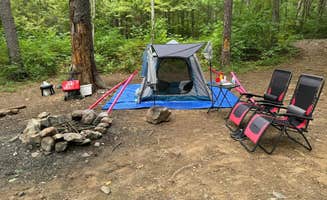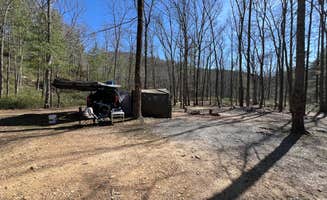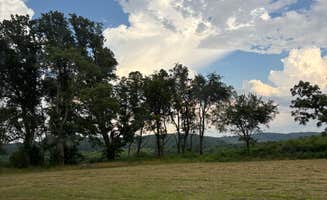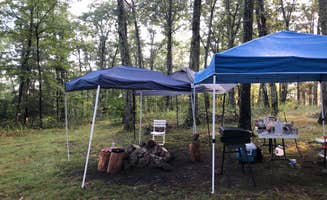Dispersed camping near Rustburg, Virginia provides opportunities for outdoor recreation at several primitive sites within an hour's drive. The region sits at elevations ranging from 500 to 3,000 feet with a mix of hardwood forests and mountain streams. Most camping areas receive moderate rainfall throughout spring and summer, with creek access available during normal precipitation levels.
What to do
Creek exploration: At George Washington National Forest off 812, most sites border streams perfect for filtering water and cooling off. "There was a fire ring and man made stone oven at the site we chose," notes camper Sawyer B., who found the creek-side sites ideal for summer visits.
Hiking trails: Multiple trails connect to dispersed camping areas, offering day hikes from camp. "There is a hike at the end of the road that takes you to a gorgeous summit and links to AT!" reports Kelly K. about Forest Road 812. These interconnected trails provide access to longer sections of the Appalachian Trail system.
Wildlife observation: Campsites at Reservoir Road Dispersed Campsite along Pedlar River offer opportunities to spot native wildlife. "Nice camping spots on the pedlar river in Amherst county. Multiple spots along reservoir rd," mentions Derek D., highlighting the natural setting that attracts various bird species and small mammals.
What campers like
Solitude and privacy: Many campers value the isolation these sites provide. "I stopped here for a night while traveling across the country... I didn't see anyone else near this site when I stayed," writes Ryan L. about his Forest Road 812 experience. The remote locations typically offer natural buffer zones between camping areas.
Rock scrambling: Spy Rock provides a unique camping experience with challenging terrain. "It is a great hike with a small rock scramble at the top for an extra bit of fun. Not only that, but the top has almost 360 degree views of the Shenandoah Valley," shares Sam M. The effort required typically means fewer campers and more privacy.
Stone cooking features: Several sites contain not just fire rings but improvised cooking setups. "There was a fire ring and man made stone oven at the site we chose," mentions Sawyer B. These rustic cooking areas, built by previous visitors, enhance the primitive camping experience without formal infrastructure.
What you should know
Access road conditions: Forest roads leading to camping areas often require careful navigation. "It is a very rocky path, about 50 feet long, to get into the campground, but then it is smooth and well laid out," Jon N. reports about a Dispersed Camping Site off FR 812. Some locations involve significant driving on unpaved surfaces.
Site availability: During peak seasons (spring and fall), arriving early improves your chances of securing a site. "Definitely get there early to get a prime spot. We didn't arrive until late afternoon but we were able to snag one down toward the end of the road," advises Sarah and James H. Weekends typically see higher occupancy rates than weekdays.
Permit requirements: Unlike national forest sites, James River Wildlife Management Area requires permits. "You simply need to purchase either a daily or annual access pass from the DWR website and then report which days you will be staying at the WMA," explains Zach K. about the process.
Tips for camping with families
Large group sites: Some areas accommodate multiple tents and vehicles. "There is a giant fire circle in the middle and enough room to fit about 10 vehicles/groups if people don't mind being next to each other," notes Jon N. about a site off Forest Road 812, making it suitable for family gatherings.
Bug protection: Seasonal insects affect comfort levels at certain times. "Went in August and it was very buggy," warns SJ W. about their Reservoir Road experience. Spring and fall typically offer more comfortable conditions with fewer mosquitoes and flies.
Cell service planning: Communication capabilities vary dramatically by location. "No cell service (T-Mobile), but if I drove towards the main road, Route 501, I could get some service," mentions Jon N. James River Wildlife Management Area offers better connectivity: "I had great T-Mobile service, but no ATT service—even with a powerful LTE antenna."
Tips from RVers
Size limitations: Most primitive sites accommodate smaller rigs only. "After turning onto Midway Mills Lane from the northern end (route 626), there is a gravel access road about .5 miles down the road that is well-maintained. It almost immediately opens up into an open field where large rigs of any size can fit," reports Zach K. about James River WMA.
Distance considerations: Distance from services affects how long you can stay comfortably. "It is 20 minutes from the closest grocery store (Food Lion), liquor store, gas station, and propane supplier," notes Zach K., making this location viable for longer stays with proper planning.





